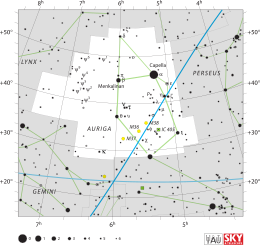Pi Aurigae
Da Wikipedia, l'enciclopedia libera.
| Pi Aurigae | |
|---|---|
| Classificazione | gigante brillante rossa |
| Classe spettrale | M3II C ~ |
| Distanza dal Sole | 841 anni luce |
| Costellazione | Auriga |
| Redshift | 0,000002 ± 0,000003 |
| Coordinate | |
| (all'epoca J2000.0) | |
| Ascensione retta | 05h 59m 56,0994s |
| Declinazione | +45° 56′ 12,248″ |
| Lat. galattica | +10,9372° |
| Long. galattica | 166,6023° |
| Dati osservativi | |
| Magnitudine app. | 4,35 |
| Magnitudine ass. | -2,71 |
| Parallasse | 3,88 ± 0,85 mas |
| Moto proprio | AR: -2,42 ± 0,95 mas/anno Dec: -7,32 ± 0,45 mas/anno |
| Velocità radiale | 0,71 ± 0,76 km/s |
| Nomenclature alternative | |
Pi Aurigae (π Aur / π Aurigae) è una stella gigante brillante rossa di magnitudine 4,35 situata nella costellazione dell'Auriga. Dista 841 anni luce dal sistema solare.
Osservazione
[modifica | modifica wikitesto]Si tratta di una stella situata nell'emisfero celeste boreale. La sua posizione è fortemente boreale e ciò comporta che la stella sia osservabile prevalentemente dall'emisfero nord, dove si presenta circumpolare anche da gran parte delle regioni temperate; dall'emisfero sud la sua visibilità è invece limitata alle regioni temperate inferiori e alla fascia tropicale. La sua magnitudine pari a 4,4 fa sì che possa essere scorta solo con un cielo sufficientemente libero dagli effetti dell'inquinamento luminoso.
Il periodo migliore per la sua osservazione nel cielo serale ricade nei mesi compresi fra fine ottobre e aprile; nell'emisfero nord è visibile anche per un periodo maggiore, grazie alla declinazione boreale della stella, mentre nell'emisfero sud può essere osservata limitatamente durante i mesi dell'estate australe.
Caratteristiche fisiche
[modifica | modifica wikitesto]La stella è una gigante brillante rossa classificata come variabile irregolare; la sua magnitudine fluttua tra la 4,24 e 4,34[1]. Possiede una magnitudine assoluta di -2,71 e la sua velocità radiale positiva indica che la stella si sta allontanando dal sistema solare.
Note
[modifica | modifica wikitesto]Voci correlate
[modifica | modifica wikitesto]Collegamenti esterni
[modifica | modifica wikitesto]- Dati della stella dall'archivio Simbad, su simbad.u-strasbg.fr.
Text is available under the CC BY-SA 4.0 license; additional terms may apply.
Images, videos and audio are available under their respective licenses.

